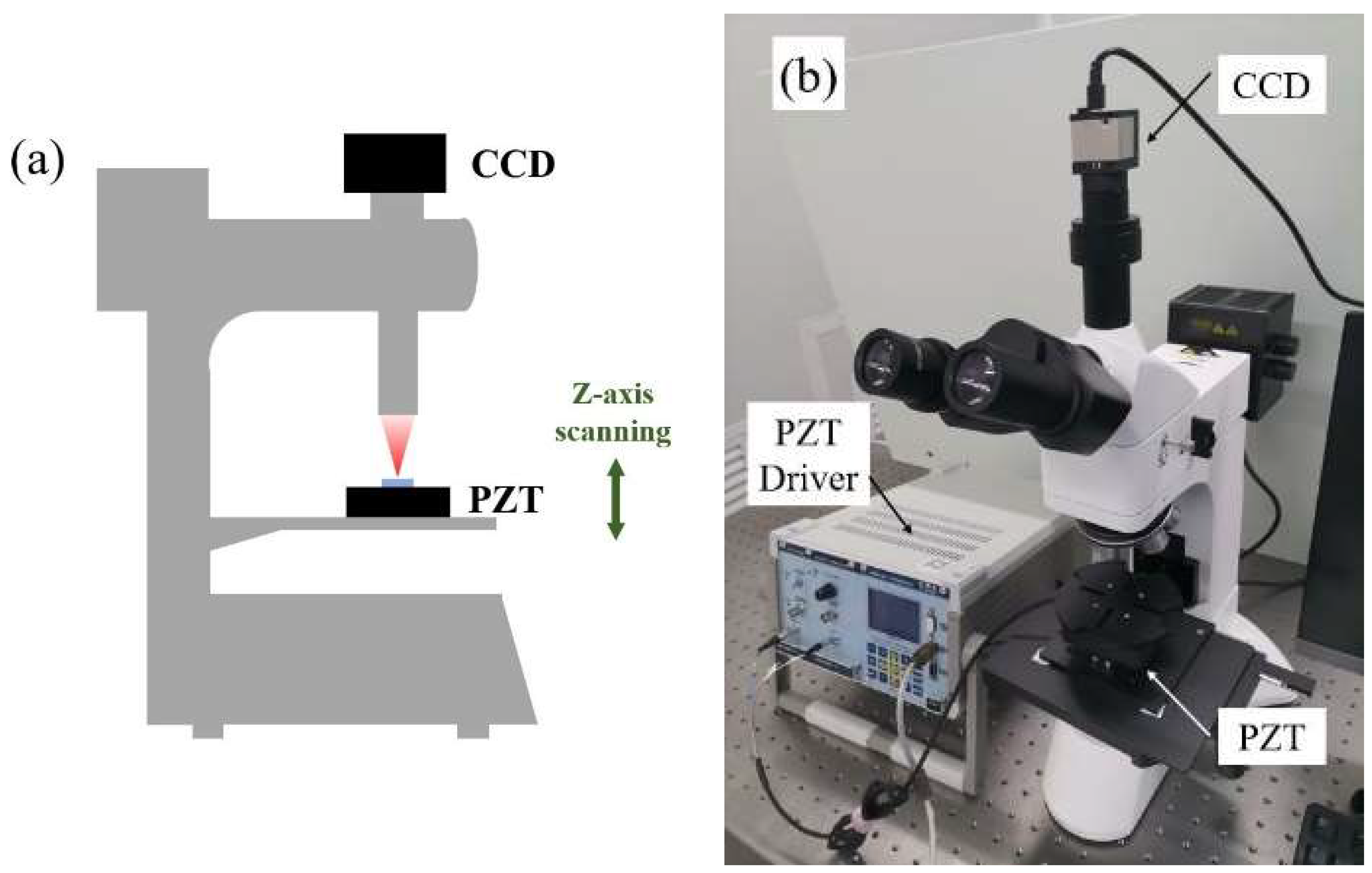MEMS High Aspect Ratio Trench Three-Dimensional Measurement Using Through-Focus Scanning Optical Microscopy and Deep Learning Method
Abstract
:1. Introduction
2. Materials and Methods
2.1. TSOM Setup
2.2. The Dataset
2.3. The Structure of the CNN
3. Results and Discussion
4. Conclusions
Author Contributions
Funding
Institutional Review Board Statement
Informed Consent Statement
Data Availability Statement
Conflicts of Interest
References
- Wang, P.; Lu, Q. Evolutionary design optimization of MEMS a review of its history and state-of-the-art. Clust. Comput. 2019, 22, 9105. [Google Scholar] [CrossRef]
- Shinde, P.; Shiurkar, U. MEMS for detection of environmental pollutants: A review pertains to sensors over a couple of decades in 21st century. Mater. Today 2021, 44, 615–624. [Google Scholar] [CrossRef]
- Bosch, S.; Xu, J. Real time etch depth measurements of mems devices. J. Microelectromech. Syst. 2002, 11, 111–117. [Google Scholar] [CrossRef]
- Xie, J. Fabrication challenges and test structures for high-aspect-ratio SOI MEMS devices with refilled electrical isolation trenches. Microsyst. Technol. 2015, 21, 1719–1727. [Google Scholar] [CrossRef]
- Kim, H.; Kim, D. Photo-assisted electrochemical etching of a nano-gap trench with high aspect ratio for MEMS applications. J. Micromech. Microeng. 2006, 16, 906–913. [Google Scholar] [CrossRef]
- Gerlt, M.; Laubli, N. Reduced etch lag and high aspect ratios by deep reactive ion etching (DRIE). Micromachines 2021, 12, 542. [Google Scholar] [CrossRef]
- Laermer, F.; Urban, A. MEMS at Bosch–Si plasma etch success story, history, applications, and product. Plasma Process. Polym. 2019, 16, 1800207. [Google Scholar] [CrossRef]
- Baklykov, D.; Andronic, M. Self-Controlled Cleaving Method for Silicon DRIE Process Cross-Section Characterization. Micromachines 2021, 12, 534. [Google Scholar] [CrossRef]
- Attota, R.; Kavuri, P. Nanoparticle size determination using optical microscopes. Appl. Phys. Lett. 2014, 105, 163105. [Google Scholar] [CrossRef] [Green Version]
- Attota, R.; Kang, H. Nondestructive shape process monitoring of three-dimensional, high-aspect-ratio targets using through-focus scanning optical microscopy. Meas. Sci. Technol. 2018, 29, 125007. [Google Scholar] [CrossRef]
- Attota, R.; Germer, T. Through-focus scanning-optical-microscope imaging method for nanoscale dimensional analysis. Opt. Lett. 2008, 33, 1990–1992. [Google Scholar] [CrossRef] [PubMed]
- Ryabko, M.; Shchekin, A. Through-focus scanning optical microscopy (TSOM) considering optical aberrations: Practical implementation. Opt. Express 2015, 23, 32215–32221. [Google Scholar] [CrossRef] [PubMed]
- Attota, R. Noise analysis for through-focus scanning optical microscopy. Opt. Lett. 2016, 41, 745–748. [Google Scholar] [CrossRef] [Green Version]
- Attota, R. Fidelity test for through-focus or volumetric type of optical imaging methods. Opt. Express 2018, 26, 19100–19114. [Google Scholar] [CrossRef]
- Park, S.; Park, G. Through-focus scanning optical microscopy with the Fourier modal method. Opt. Express 2018, 26, 11649–11657. [Google Scholar] [CrossRef] [PubMed] [Green Version]
- Park, S.; You, B. Metrological sensitivity improvement of through-focus scanning optical microscopy by controlling illumination coherence. Opt. Express 2019, 27, 1981–1990. [Google Scholar] [CrossRef] [PubMed]
- Rim, M.; Agocs, E. Detecting nanoscale contamination in semiconductor fabrication using through-focus scanning optical microscopy. J. Vac. Sci. Technol. B Nanotechnol. Microelectron. Mater. Process. Measur. Phenom. 2020, 38, 050602. [Google Scholar] [CrossRef]
- Peng, R.; Jiang, J. Lateral movement and angular illuminating non-uniformity corrected TSOM image using Fourier transform. Opt. Express 2020, 28, 6294–6305. [Google Scholar] [CrossRef]
- Lee, J.; You, B. Motion-free TSOM using a deformable mirror. Opt. Express 2020, 28, 16352–16362. [Google Scholar] [CrossRef]
- Qu, Y.; Hao, J. Machine-learning models for analyzing TSOM images of nanostructures. Opt. Express 2019, 27, 33978–33998. [Google Scholar] [CrossRef]
- Kwak, H.; Ryu, S. Non-destructive thickness characterisation of 3D multilayer semiconductor devices using optical spectral measurements and machine learning. Light: Adv. Manuf. 2021, 2, 9–11. [Google Scholar] [CrossRef]
- Li, G.; Shi, J. Through-focus scanning optical microscopy measurement based on machine learning. Chin. Opt. 2022, 15, 703–711. (In Chinese) [Google Scholar]
- Dalal, N.; Triggs, B. Histograms of oriented gradients for human detection. In Proceedings of the IEEE Conference on Computer Vision and Pattern Recognition, San Diego, CA, USA, 20–25 June 2005. [Google Scholar]
- Basak, D.; Srimanta, P. Support Vector Regression. Neur. Inform. Proc. 2007, 11, 203. [Google Scholar]
- Yan, G.; Zhu, Y. Parameters Selection Method for Support Vector Machine Regression. Comput. Eng. 2009, 35, 218. (In Chinese) [Google Scholar]









Publisher’s Note: MDPI stays neutral with regard to jurisdictional claims in published maps and institutional affiliations. |
© 2022 by the authors. Licensee MDPI, Basel, Switzerland. This article is an open access article distributed under the terms and conditions of the Creative Commons Attribution (CC BY) license (https://creativecommons.org/licenses/by/4.0/).
Share and Cite
Li, G.; Shi, J.; Gao, C.; Jiang, X.; Huo, S.; Cui, C.; Chen, X.; Zhou, W. MEMS High Aspect Ratio Trench Three-Dimensional Measurement Using Through-Focus Scanning Optical Microscopy and Deep Learning Method. Appl. Sci. 2022, 12, 8396. https://doi.org/10.3390/app12178396
Li G, Shi J, Gao C, Jiang X, Huo S, Cui C, Chen X, Zhou W. MEMS High Aspect Ratio Trench Three-Dimensional Measurement Using Through-Focus Scanning Optical Microscopy and Deep Learning Method. Applied Sciences. 2022; 12(17):8396. https://doi.org/10.3390/app12178396
Chicago/Turabian StyleLi, Guannan, Junkai Shi, Chao Gao, Xingjian Jiang, Shuchun Huo, Chengjun Cui, Xiaomei Chen, and Weihu Zhou. 2022. "MEMS High Aspect Ratio Trench Three-Dimensional Measurement Using Through-Focus Scanning Optical Microscopy and Deep Learning Method" Applied Sciences 12, no. 17: 8396. https://doi.org/10.3390/app12178396
APA StyleLi, G., Shi, J., Gao, C., Jiang, X., Huo, S., Cui, C., Chen, X., & Zhou, W. (2022). MEMS High Aspect Ratio Trench Three-Dimensional Measurement Using Through-Focus Scanning Optical Microscopy and Deep Learning Method. Applied Sciences, 12(17), 8396. https://doi.org/10.3390/app12178396





